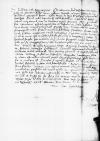Letter #3809
Cornelis DE SCHEPPER to Ioannes DANTISCUSPuente Duero, 1527-02-22
English register:
De Schepper thanks Dantiscus for his letter. Nestor [Mercurino Gattinara] is very upset by the news from Italy, to the point that he is unable as yet to deal with the request/document of Dantiscus that was transmitted to him by De Schepper. He promised an answer, but it is not appropriate to insist for the time being. The news about the conflict between the Spanish and German troops in Italy is very worrying.
The Pope [Clement VII] has tried to buy off the Viceroy [Charles de Lannoy] so that he will withdraw his troops. The Florentines have offered money to safeguard the city from destruction. The Viceroy has asked [Charles] de Bourbon to send him 60.000 ducats by bill of exchange.
The [papal and French] army leaders Guido Rangoni, Federico a Bozzolo, and the Marquis of Saluzzo [Michele Antonio Ludovico del Vasto] are holding Piacenza, Parma and Bologna. There is no news on the German conspiracy against the Medici. The enemy tries to lure the Duke of Ferrara [Alfonso d'Este] into their camp, by promising him the restitution of Modena, the marriage of his eldest son to [Catherine] de’ Medici, and a cardinalate for the younger. De Schepper will be arriving on Monday; in the meantime he will be taking care of Dantiscus' interests. He recommends himself to his relations at court.
Manuscript sources:
Auxiliary sources:
Prints:
| ||||||||||||
Text & apparatus & commentary Plain text Text & commentary Text & apparatus
Clarissimo Domino
Salutem.
cf.
De direptione
Coniuratio
Nos venturi sumus feria secunda. Interea me tibi, uti parenti, commendo. Rebus tuis curandis ita persuade, tibi omnem operam me impensurum esse. Commenda me reverendo domino
Bene vale.
Ex
Tuus servus superlativus


 AAWO, AB, D.3, f. 11v
AAWO, AB, D.3, f. 11v